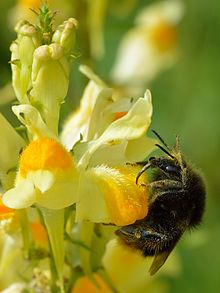Linaria
| Linaria | |
|---|---|

| |
| Common toadflax (Linaria vulgaris) | |
| Scientific classification | |
| Kingdom: | Plantae |
| Clade: | Tracheophytes |
| Clade: | Angiosperms |
| Clade: | Eudicots |
| Clade: | Asterids |
| Order: | Lamiales |
| Family: | Plantaginaceae |
| Tribe: | Antirrhineae |
| Genus: | Linaria Mill. |
| Species | |
|
See text | |
Linaria is a genus of 150 species of flowering plants, one of several related groups commonly called toadflax. They are annuals and herbaceous perennials, and the largest genus in the Antirrhineae tribe of the plantain family Plantaginaceae.
Taxonomy
Linaria was traditionally placed in the family Scrophulariaceae. Phylogenetic analysis has now placed it in the vastly expanded family Plantaginaceae.
Closely related genera include the Nuttallanthus (American toadflaxes, recently split from Linaria), Antirrhinum (snapdragons) and Cymbalaria (ivy-leaved toadflaxes).
Cultivation
Several Linaria species are cultivated as garden plants, notably L. alpina (alpine toadflax), L. maroccana (Moroccan toadflax), L. purpurea (purple toadflax) and L. vulgaris (common toadflax).[1]
Species
Some of the more familiar Linaria include:
- Common toadflax or butter-and-eggs (Linaria vulgaris), a European species which is widely introduced elsewhere and grows as a common weed in some areas.
- Broomleaf toadflax or Dalmatian toadflax (Linaria genistifolia, syn. L. dalmatica), a native of southeast Europe that has become a weed in parts of North America.[2]
- Purple toadflax (Linaria purpurea), a species native to the Mediterranean region grown as a garden plant for its dark purple or pink flowers.
- Pale toadflax (Linaria repens), a species from western Europe similar to L. purpurea, but with paler flowers.
Etymology
The members of this genus are known in English as toadflax, a name shared with several related genera. The 'toad' in toadflax may relate to the plants having historically been used to treat bubonic plague, a false link having been drawn between the words 'bubo' and 'Bufo'. The scientific name Linaria means "resembling linum" (flax), which the foliage of some species superficially resembles.
Distribution and habitat
The genus is native to temperate regions of Europe, northern Africa and Asia, with the highest species diversity in the Mediterranean region.
Ecology
Some Linaria are regarded as noxious weeds. They are likely toxic to livestock, but ruminants generally avoid them.[3]
Uses
Toadflaxes are used as food plants by the larvae of some Lepidoptera species, including the mouse moth (Amphipyra tragopoginis) and the common buckeye (Junonia coenia). L. vulgaris has been used as a medicinal herb for the treatment of many illnesses and conditions, including cancer, hepatitis, hemorrhoids, scrofula, and scurvy. It has been used as an astringent, an emollient and a laxative.[4]
References
- ^ Brickell, Christopher, ed. (2008). The Royal Horticultural Society A-Z Encyclopedia of Garden Plants. United Kingdom: Dorling Kindersley. p. 636. ISBN 9781405332965.
- ^ Dalmatian Toadflax (Linaria dalmatica). National Invasive Species Information Center, United States National Agricultural Library.
- ^ Sing, S. E. and R. K. Peterson. (2011). Assessing environmental risks for established invasive weeds: Dalmatian (Linaria dalmatica) and yellow (L. vulgaris) toadflax in North America. International Journal of Environmental Research and Public Health 8(7) 2828-53.
- ^ Duke, J. A. Ethnobotanical uses: Linaria vulgaris. Dr. Duke's Phytochemical and Ethnobotanical Databases.
Bibliography
- A Phylogeny of Toadflaxes (Linaria Mill.) Based on Nuclear Internal Transcribed Spacer Sequences: Systematic and Evolutionary Consequences. Mario Fernández-Mazuecos, José Luis Blanco-Pastor, and Pablo Vargas. International Journal of Plant Sciences, Vol. 174, No. 2 (February 2013), pp. 234–249 Published by: The University of Chicago Press, Article DOI: 10.1086/668790
- Vargas P, JA Rosselló, R Oyama, J Güemes. 2004 Molecular evidence for naturalness of genera in the tribe Antirrhineae (Scrophulariaceae) and three independent evolutionary lineages from the New World and the Old. Plant Systematics and Evolution 249:151–172.
